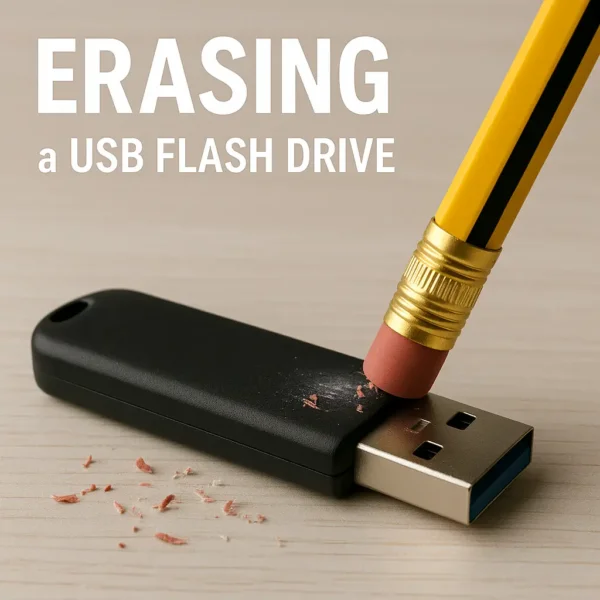Permanently erasing a flash drive: Have you ever wondered how to permanently delete files from a USB drive so no one can recover them? In this tutorial, we show you how to wipe USB drives using Linux, making sure that your files are gone for good.
Erasing a Flash Drive to Permanently Delete Files

Why Just Deleting Files from Drives Isn't Enough
When you delete a file from a USB drive, the file is not truly gone. Even after you empty your trash, the data is still there and can be recovered unless it gets overwritten with new information. This is why simply deleting files does not guarantee your privacy.
Warning: Data Loss is Permanent
Once you proceed with any of these methods, the data on your USB drive will be permanently lost. Ensure that you have backed up any important files before continuing, as this process is irreversible, especially if you perform multiple passes.
How to Wipe a USB Drive in Linux
To Wipe USB drives, we can use the dd command in Linux to overwrite empty space on a USB drive with zeros, making deleted files nearly impossible to recover. Here's how:
- Open a terminal window: Press Ctrl + Alt + T to open the terminal.
- Find your USB drive: Type the following command to list all drives and find your USB device letter. Press Enter to run it:
sudo fdisk -l - Create a mount directory: We need a directory to mount the drive. Run:
sudo mkdir /tmp/ddusb - Mount your USB drive: Replace x and # with your USB drive's letter and partition number, then run this command:
sudo mount -o loop /dev/sdx# /tmp/ddusb - Zero out the empty space: Overwrite all empty space on the USB drive with zeros by running:
sudo dd if=/dev/zero of=/tmp/ddusb/junk.bin status=progressThis process may take some time. Wait until you see "no space left on device."
- Delete the junk file: Once the process is complete, remove the file that filled the space:
sudo rm /tmp/ddusb/junk.bin
Other Methods for Wiping a USB Drive
Besides using the dd command, there are other powerful tools in Linux to securely wipe your USB drive. Two popular alternatives are Shred and Wipe. Here's how to use them:
Securely Delete Files using Shred:
The shred command allows you to overwrite files or entire partitions with random data multiple times, making recovery much more difficult. Here's how you can use shred to wipe a USB drive:
- Find your USB drive: Start by identifying your USB device using the following command:
sudo fdisk -l - Use shred to wipe USB drives: To securely erase the entire USB drive with shred, you can run:
sudo shred -v -n 3 /dev/sdx- -v: Verbose mode, showing progress as the command runs.
- -n 3: Specifies the number of passes. In this case, it will overwrite the USB three times. You can increase this number for added security.
- /dev/sdx: Replace x with the correct letter for your USB drive.
This process may take some time depending on the size of your USB drive.
Use Wipe to Erase a USB Drive:
The wipe command erases the contents of your USB drive by overwriting it with multiple secure passes. To install wipe and use it, follow these steps:
- Install wipe: If wipe is not installed on your system, you can install it using your package manager. Run the following command:
sudo apt install wipe - Use wipe to erase USB drives: Once installed, you can wipe your USB drive by running:
sudo wipe /dev/sdx- /dev/sdx: Replace x with the correct letter for your USB drive.
Wipe will securely erase the USB drive by making multiple passes, ensuring that the data is nearly impossible to recover.
How to Format Your USB Drive After Wiping
After erasing a USB drive, you can reformat it to make it usable again. To format the USB drive with the ext4 file system, for example, you can run:
sudo mkfs.ext4 /dev/sdx#Replace x and # with the correct device name.
Random Data vs. Zeros
Although overwriting with zeros is effective, using random data offers an extra layer of security. Forensic tools may still recover some patterns from zeroed out drives, while random data makes this much more difficult. To overwrite with random data, modify the dd command like this:
sudo dd if=/dev/urandom of=/tmp/ddusb/junk.bin status=progressThis method is slower but provides a higher level of data destruction.
Best Practices for USB Drive File Security
To further protect your data, consider these best practices for USB flash drive file security:
- Encrypt your files: Before wiping, encrypt sensitive data with tools like gpg or LUKS to make sure it can't be read, even if recovered.
- Restore and Format the USB drive: After securely erasing a flash drive, restore the USB drive format to ensure it is clean and ready for reuse.
Troubleshooting Common Issues
- Permission denied errors? Make sure you are using sudo with administrative privileges for all commands.
Final Thoughts and Data Recovery
That's all it takes to wipe USB flash drives! You've now filled the empty space on your USB drive with zeros, making deleted files hard to recover. If you need extra security, you should repeat the process several times for added peace of mind.
Note: Overwriting a USB drive with zeros is known to be an acceptable method to use for data destruction. However, even though you have permanently deleted files from the USB drive, advanced forensic tools might still be able to recover some of the deleted data. For more security, you might consider making multiple passes.
